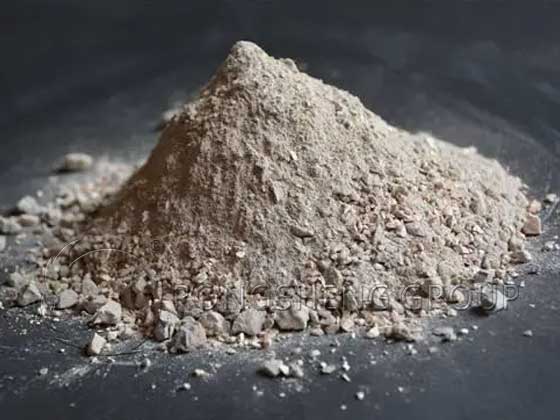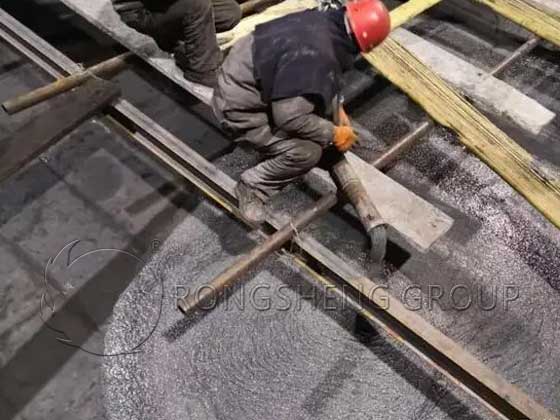The construction technology of refractory castables is an important aspect that affects the use effect of High Temperature Castable Refractory Linings. Therefore, the construction of high temperature castable refractory is also the key to the service life of refractory castables in kilns. This is related to the service life and maintenance cycle of the refractory lining of the high-temperature kiln.

Construction Technology of High Temp Castable Refractory
1) Preparation of High Temp Castable Refractory
- ◇The ratio of raw materials for High Temp Castable Refractory must be strictly in accordance with the design or manufacturer’s technical instructions. It can only be applied to the construction project after being confirmed by the trial matching test, and all kinds of materials should be measured accurately.
- ◇Mixing method adopts forced mixer. The mixing water should be drinking water, and the amount of water added should be strictly controlled during the stirring process. The feeding sequence and mixing time are in accordance with the instructions or technical requirements of the supplier. When sporadic materials are used, manual stirring can be used, and at least 4 back and forths should be stirred.
- ◇Adopt the principle of a small amount of frequent stirring. The High Temp Castable Refractory has rapid hardening after mixing, and the mix should generally be used up within 30 minutes. For this reason, the mixer should be as close to the place of use as possible to shorten the transportation distance and time. Mix the ingredients for the second time after each mixing is used up. It is better to wait for the ingredients than to wait for the ingredients. The remaining material that has been initially set shall not be used.

2) The construction ambient temperature should be >5°C according to the specifications. When the temperature is lower than 5°C, it is generally not recommended to carry out the construction of castable refractory lining projects.
3) Casting molding. Pay attention to the compactness of the slider and corners, and do not use mechanical vibration to avoid segregation. The thickness of the lining is controlled by the side mold, and the thickness can be measured by a probe in the middle. Pat the molding surface densely and evenly, and rub it with a wooden trowel. The construction joints should be left as stepped joints, cleaned up and fully moistened before continuing construction. Pay attention to adding slurry and vibrating at the seams to ensure the tightness of the seams.
4) Conservation. Generally, it is cured in a humid state for 24-72 hours, and the curing temperature is 5-30°C. According to the manufacturer’s technical instructions, the maintenance stipulates that the ambient temperature should be ≤25°C and the natural curing should be done for 3 days. When the temperature is >25°C, carry out humid curing. According to the construction experience, the lining will be cured after 2 hours of construction. If the ambient temperature is 20-25°C, use a sprayer to spray once every 2-3 hours, and spray once every 1.5 hours if the temperature is >25°C. It is maintained for 48 hours, and it is advisable to control the amount of water spray so that it does not flow.
5) Test block production. During the construction of each ingredient, according to the specification, every 20m3 is a batch of indwelling test blocks, and the inspection items are bulk density, compressive strength, flexural strength, and line change after burning.
Retention of expansion joints in high temperature castable refractory construction
During the construction of high temperature castable refractory, expansion joints should be reserved according to the design. When there is no provision in the design drawings, well-shaped expansion joints can be left at a distance of 800-1200mm. The general seam width is 2-3mm. It can also be cut into slits after forming, and the slit depth is 20-30mm in thickness.

Construction of Refractory Castables in Furnace Bottom Lining
The furnace bottom lining should be carried out after all the work in the furnace is completed and the scaffolding is completely removed. Specific requirements for the Construction of Refractory Castables in Furnace Bottom Lining are as follows.
1) The surface should be flat and free from pockmarks, and cracks.
2) The lining should be dense. Use a 0.5kg hand hammer to lightly tap every 200mm for inspection. The sound should be sonorous and crisp, and serious “husky” or hollow drumming is not allowed. Otherwise, it should be chiseled off and poured again.
High temperature castable refractory lining repair
After baking, if the high temperature castable refractory lining has cracks or penetrating network cracks with a width greater than 5mm, it must be repaired.
1) Partial chisel removal. Chisel off all the defective parts to expose the solid surface or steel surface. For the lining with insulation nails, at least two insulation nails should be exposed. The chiseled place should form a pit with a large inside and a small outside. The minimum area of the pit mouth is 300×600mm for the outer opening and 400×700mm for the inner opening.
2) Partial repair. ①Clean up the joint surface, remove loose material and floating ash, soak it with water first, then carefully tamp it with the same proportion of lining material, and smooth it. ② Cracks with a width greater than 5mm or penetrating network cracks should be filled with high-temperature adhesive + refractory fiber.
Precautions in the construction of high temperature castable refractory
- The suitable construction temperature is 10°C-30°C. When the temperature is too low, conditions should be created.
- When the relative humidity of the air exceeds 85%, it is not suitable for construction.
- When the surface temperature of the steel plate is lower than 3°C above the atmospheric dew point or higher than 60°C, it is not suitable for construction.
- It is not suitable for construction on windy and sandy days, rainy and foggy days.
Rongsheng Kiln Refractory Manufacturer
Rongsheng Kiln Refractory Manufacturer is a refractory manufacturer with rich experience in production, sales, and construction. The refractory lining materials provided by Rongsheng include not only monolithic refractory castables but also various types of refractory bricks. For monolithic refractories and refractory bricks, we support product customization to meet the working needs of thermal kilns. At the same time, the design and construction of our refractory insulation layer are also excellent. The design and construction of the thermal insulation refractory project of the rotary kiln we have served has greatly reduced the temperature of the outer wall, providing a reliable guarantee for safe production and cost savings. contact us for more, at sales@kilnrefractory.com.